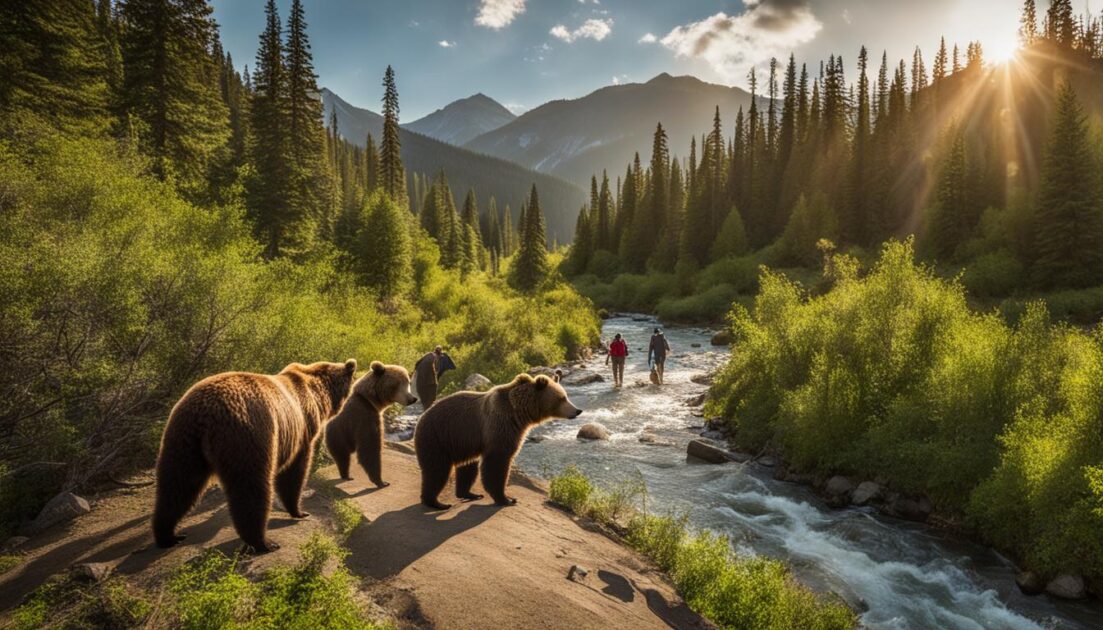Are you ready for an unforgettable hiking adventure? Look no further than Katmai National Park, home to some of the best hiking trails in the United States. With its breathtaking landscapes, diverse wildlife, and remote wilderness, Katmai offers a truly immersive outdoor experience. Whether you’re a novice hiker or an experienced trekker, there’s something for everyone in this extraordinary national park.
If you’re new to hiking or prefer a more leisurely pace, Katmai has a variety of easy trails that showcase the park’s natural beauty. On the other hand, if you’re up for a challenge and seek a deeper connection with the wilderness, there are also challenging routes that will test your skills and reward you with stunning vistas.
Exploring Katmai’s hiking trails can be done independently or with the guidance of experienced tour operators who can provide valuable insights and ensure your safety throughout the journey. Proper hiking gear is essential for a comfortable and enjoyable experience, and our seasonal tips will help you make the most of your adventure in Katmai.
- Explore the diverse hiking trails in Katmai National Park, from easy walks to challenging treks.
- Experience the beauty of Katmai’s landscapes, wildlife encounters, and historical significance.
- Choose between self-guided hikes or join guided tours for a safe and informative adventure.
- Equip yourself with proper hiking gear to ensure comfort and safety along the trails.
- Consider the seasonal variations and plan your hike accordingly for the best experience.
Easy Hiking Trails in Katmai National Park
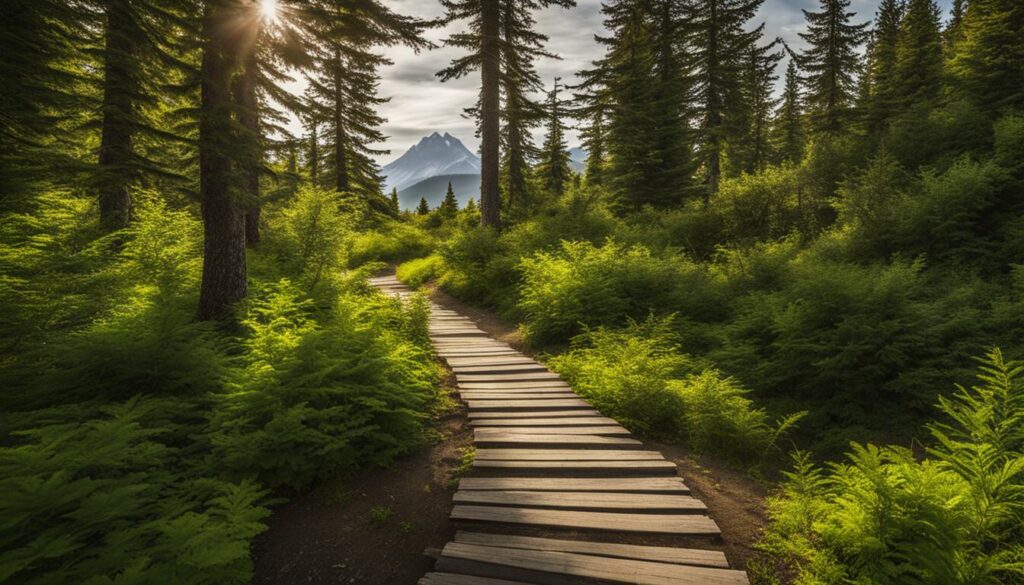
If you’re a beginner or looking for a leisurely hike, Katmai National Park offers a range of easy hiking trails that showcase the park’s natural beauty. These trails are perfect for those who want to enjoy scenic walks and immerse themselves in the stunning landscapes of Katmai.
Brooks River Trail
One of the most popular easy hikes in Katmai is the Brooks River Trail. This trail takes you along the picturesque Brooks River, where you can witness salmon swimming upstream and bears catching their food. The trail is well-maintained and offers stunning views of the surrounding wilderness.
Dumpling Mountain Trail
If you’re looking for panoramic views of Katmai National Park, the Dumpling Mountain Trail is a must-visit. This trail takes you to the summit of Dumpling Mountain, where you can enjoy breathtaking vistas of the park and its rugged landscapes. The trail is relatively easy, but be prepared for some uphill sections.
Valley of Ten Thousand Smokes Overlook Trail
For a unique hiking experience, head to the Valley of Ten Thousand Smokes Overlook Trail. This trail offers a glimpse into the aftermath of the 1912 volcanic eruption that shaped the park. As you hike to the overlook, you’ll witness the vast expanse of volcanic ash deposits and steam vents, creating a surreal and otherworldly landscape.
These easy hiking trails in Katmai National Park provide a chance to connect with nature and appreciate the wonders of the park at a relaxed pace. Whether you choose to explore the scenic Brooks River, hike to the summit of Dumpling Mountain, or witness the geological marvels of the Valley of Ten Thousand Smokes, these trails offer a memorable experience for hikers of all levels.
Challenging Hiking Trails in Katmai National Park
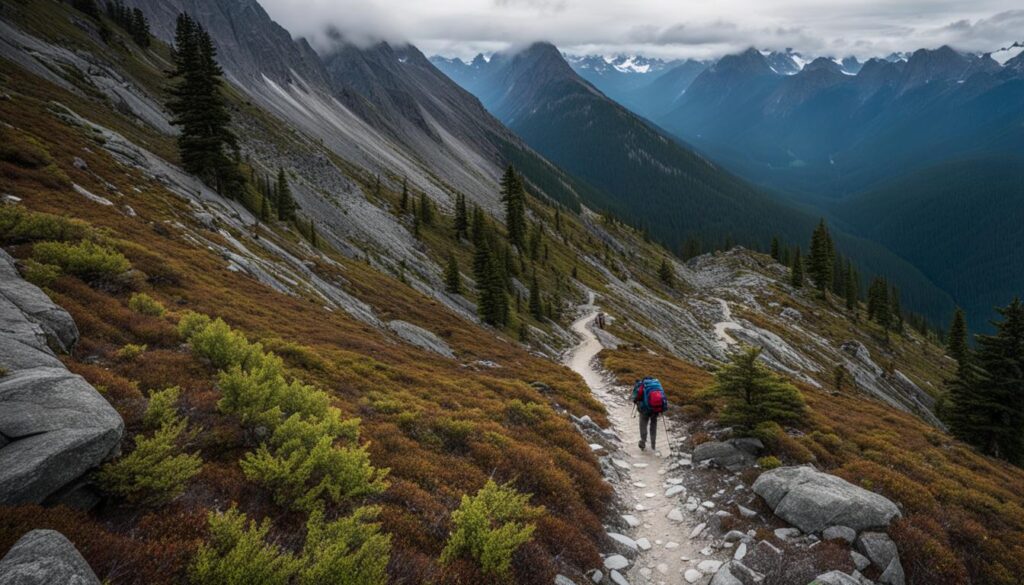
If you’re an experienced hiker looking for a thrilling adventure, Katmai National Park offers a variety of challenging trails that will put your skills to the test. These trails take you deep into the backcountry, offering breathtaking views and a true sense of exploration. Here are some of the most challenging hikes in Katmai:
1. Katmai Valley Route
The Katmai Valley Route is a demanding trail that takes you through rugged terrain and remote areas of the park. This multi-day hike offers stunning views of the surrounding mountains, valleys, and rivers. It requires advanced navigation skills and a high level of fitness, but the sense of accomplishment after completing this trail is truly rewarding.
2. Alagnak Wild River Trail
The Alagnak Wild River Trail is a strenuous hike that follows the scenic Alagnak River. This trail offers opportunities for fishing, wildlife viewing, and camping along the way. With its challenging terrain and unpredictable weather conditions, this trail is recommended for experienced hikers looking for an immersive wilderness experience.
3. Novarupta Trail
The Novarupta Trail takes you to the site of the 1912 volcanic eruption that shaped the landscape of Katmai National Park. This challenging hike offers unique geological features, including volcanic ash deposits and steaming fumaroles. It requires careful navigation and preparation, but the chance to witness the aftermath of a volcanic eruption makes it a truly remarkable experience.
When embarking on these challenging hikes, it is essential to be well-prepared and equipped with the necessary gear. Carry a map, compass, and GPS device, and ensure you have adequate food, water, and emergency supplies. It’s also important to check weather conditions and trail updates before setting out on your hike. Remember to prioritize safety and respect the wilderness of Katmai National Park.
Table: Comparison of Challenging Hiking Trails in Katmai National Park
| Hiking Trail | Difficulty Level | Trail Length | Elevation Gain | Highlights |
|---|---|---|---|---|
| Katmai Valley Route | Difficult | Approximately 50 miles | Varies | Remote wilderness, scenic views, wildlife encounters |
| Alagnak Wild River Trail | Strenuous | Approximately 25 miles | Varies | Fishing, camping, wildlife viewing |
| Novarupta Trail | Challenging | Approximately 20 miles | Varies | Volcanic landscapes, geological features |
These challenging hiking trails in Katmai National Park offer an opportunity to test your skills and experience the untamed beauty of the Alaskan wilderness. Take on the adventure, embrace the physical and mental challenges, and create unforgettable memories in one of the most awe-inspiring national parks in the United States.
Hiking in Katmai: Summer vs. Winter
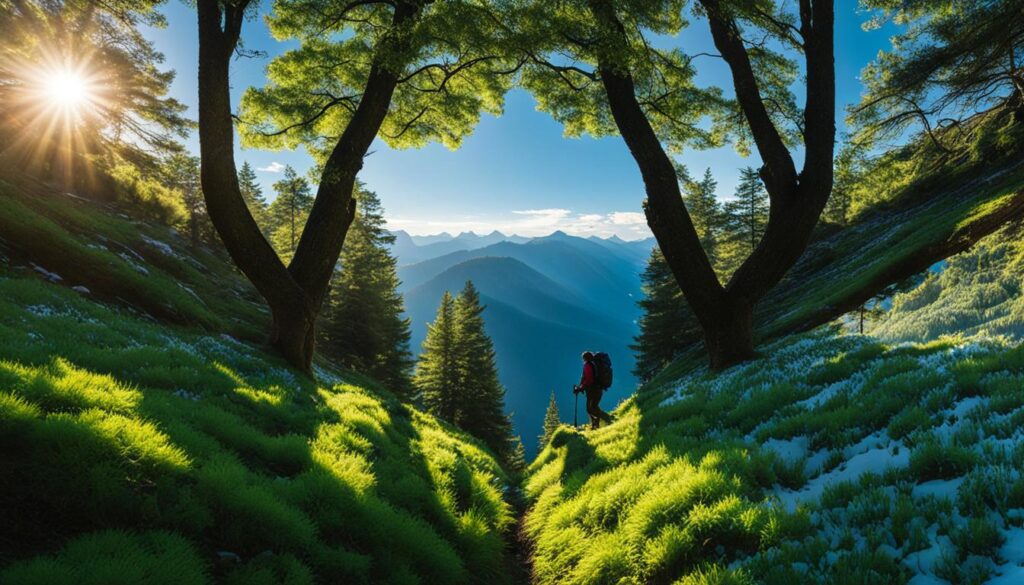
When it comes to hiking in Katmai National Park, the experience can vary greatly depending on whether you choose to explore during the summer or winter months. Each season offers its own unique beauty and challenges, making it important to consider the seasonal differences in hiking in order to plan your trip effectively. In this section, I will explore the highlights of summer and winter hiking in Katmai and provide insights into the best time to hike in this stunning wilderness.
Summer Hiking in Katmai
During the summer, Katmai National Park comes alive with vibrant colors, lush vegetation, and an abundance of wildlife. The park is teeming with activity, offering hikers the opportunity to witness bears fishing for salmon, observe a variety of bird species, and marvel at the stunning landscapes painted with wildflowers. The trails are more accessible, allowing visitors to explore the park’s diverse terrain, from volcanic landscapes to meandering rivers. The pleasant weather and longer daylight hours create the perfect conditions for a memorable hiking adventure.
However, it’s important to note that summer hiking in Katmai can be popular, especially in areas such as Brooks Camp. It’s advisable to make camping reservations well in advance and be prepared for potentially crowded trails. Additionally, it’s essential to follow bear safety protocols as encounters with these magnificent creatures are more prevalent during the summer months.
Winter Hiking in Katmai
Winter hiking in Katmai offers a completely different experience, with snow-covered landscapes and a sense of tranquility. The park becomes a winter wonderland, providing hikers with the opportunity to explore its pristine beauty in solitude. The trails may be less crowded, allowing for a more intimate connection with nature. However, winter hikes in Katmai require additional precautions and preparation.
The weather during winter can be harsh, with freezing temperatures and snowy conditions. It’s crucial to dress appropriately in layers and have the necessary gear, including traction devices for your boots and avalanche safety equipment if venturing into higher elevation areas. Navigational skills and knowledge of winter backcountry travel are also essential for a safe and enjoyable winter hiking experience.
Best Time to Hike in Katmai
The best time to hike in Katmai ultimately depends on your preferences and the type of experience you seek. If you’re interested in witnessing the incredible wildlife activity and vibrant landscapes, summer hiking offers a fantastic opportunity. On the other hand, if you prefer a more serene and secluded adventure, winter hiking may be the ideal choice.
It’s worth noting that the transition periods between seasons, such as late spring and early fall, can also be excellent times to hike in Katmai. These shoulder seasons offer a balance between wildlife encounters, favorable weather conditions, and fewer crowds.
| Season | Highlights | Considerations |
|---|---|---|
| Summer | – Vibrant colors and lush vegetation – Abundance of wildlife – Longer daylight hours |
– Popular and potentially crowded – Bear encounters |
| Winter | – Tranquility and solitude – Unique winter landscapes – Less crowded trails |
– Harsh weather conditions – Additional gear and precautions |
| Shoulder Seasons | – Balance between wildlife, weather, and crowds | – Advantages of both seasons may be limited |
Whether you decide to embark on a summer or winter hiking adventure in Katmai, one thing is certain: the park’s natural beauty and diverse landscapes will leave a lasting impression. Always remember to prioritize safety, adhere to park regulations, and respect the wilderness you’re exploring. Happy hiking!
Historical Significance of Katmai National Park

Katmai National Park holds a rich historical legacy that adds depth and intrigue to the hiking experience. The park’s cultural heritage is evident through its archaeological sites, which provide valuable insights into the ancient cultures that once thrived in this region. Exploring these sites not only allows us to understand the past but also to appreciate the deep connection between humans and nature in this remarkable landscape.
One of the notable aspects of Katmai’s history is the volcanic eruption that took place in 1912. This cataclysmic event left a lasting impact on the park, creating the iconic Valley of Ten Thousand Smokes. The eruption, which lasted for three days, drastically altered the landscape and filled the valley with ash and steam vents. Today, this geological marvel stands as a testament to the power of nature and the ongoing processes that shape our planet.
“Katmai National Park is a living testament to the interconnectedness of history, culture, and the natural world. Exploring the archaeological sites and witnessing the volcanic landscapes is a humbling experience that reminds us of the profound forces that have shaped this land.”
Archaeological Sites in Katmai National Park
As I embarked on my hiking adventure in Katmai, I had the opportunity to visit some of the park’s archaeological sites. These sites are scattered throughout the park and reveal remnants of ancient dwellings, artifacts, and cultural practices. Walking through these sites, I couldn’t help but feel a sense of wonder and admiration for the people who lived here long ago.
To truly appreciate the historical significance of these sites, I joined a guided tour led by knowledgeable park rangers. They shared captivating stories about the people who once inhabited the area, their daily lives, and their relationship with the land. It was fascinating to hear how these ancient cultures adapted to the harsh environment and made a life for themselves in harmony with nature.
The Legacy of Katmai National Park
Preserving the historical and cultural heritage of Katmai National Park is of utmost importance. It allows us to learn from the past, gain a deeper appreciation for the land we explore, and ensure the legacy of these ancient cultures endures for generations to come. By incorporating the historical significance of Katmai into our hiking adventures, we not only embark on a physical journey but also a journey through time and the human experience.
As I reflect on my time in Katmai, I am grateful for the opportunity to witness the remarkable historical and cultural richness of this national park. It has deepened my understanding of the land, its people, and the intricate relationship between humankind and nature. Hiking in Katmai is a truly transformative experience that encompasses not only the grandeur of the natural world but also the enduring significance of its diverse history.
Geological Wonders in Katmai National Park

Katmai National Park is a treasure trove of geological wonders, showcasing the powerful forces of nature that have shaped its landscapes over millions of years. From volcanic formations to rugged terrains, the park offers a fascinating glimpse into the geology of the region.
The Valley of Ten Thousand Smokes
One of the most remarkable geological features in Katmai National Park is the Valley of Ten Thousand Smokes. This sprawling valley was formed by the eruption of the Novarupta volcano in 1912, which deposited a thick layer of volcanic ash over the surrounding area. As the ash cooled and solidified, it created a unique landscape characterized by thousands of chimneys, steam vents, and ash deposits.
The Valley of Ten Thousand Smokes offers a mesmerizing sight, with its stark contrasts of white ash against the greenery of the surrounding vegetation. It is a testament to the power and beauty of volcanic activity, and a reminder of the ever-changing nature of our planet.
Volcanic Landscapes
Katmai National Park is home to numerous volcanic landscapes that bear witness to its volcanic past. The park sits within the Pacific Ring of Fire, a region known for its intense volcanic activity. The rugged peaks of the Aleutian Range, including Mount Katmai and Mount Mageik, are remnants of past volcanic eruptions.
These volcanic landscapes offer a unique experience for hikers, with their dramatic scenery and diverse ecosystems. From lush valleys to barren lava fields, each trail reveals a different facet of the geological history of Katmai National Park.
The Geology of Katmai
Katmai National Park is a geological wonderland, with its diverse range of rock formations, fault lines, and glacial features. The park’s geology is a result of tectonic forces, volcanic activity, and the erosive power of glaciers.
Exploring the geology of Katmai is like taking a journey through time, with each rock layer holding clues to the past. From the ancient volcanic rocks of the Aleutian Range to the glacially-carved valleys, the park offers a unique opportunity to study and appreciate the Earth’s geological history.
| Geological Features | Description |
|---|---|
| The Valley of Ten Thousand Smokes | A vast valley filled with volcanic ash deposits, steam vents, and ash chimneys. |
| Volcanic Peaks | The Aleutian Range is home to the iconic Mount Katmai and Mount Mageik, volcanic peaks that offer stunning views. |
| Glacial Valleys | The park’s valleys bear witness to the erosive power of glaciers, showcasing U-shaped valleys and moraines. |
| Fault Lines | The region is intersected by various fault lines, reflecting the tectonic forces at work. |
Exploring the geological wonders of Katmai National Park is a truly awe-inspiring experience. From the Valley of Ten Thousand Smokes to the volcanic peaks and glacial valleys, this unique landscape offers a glimpse into the Earth’s turbulent past. It serves as a reminder of the immense power and beauty of geological processes, and the importance of preserving these natural wonders for future generations.
Wildlife Encounters on Katmai Hikes
One of the most incredible aspects of hiking in Katmai National Park is the abundance of wildlife that can be observed along the trails. The park is home to a diverse range of species, making each hike a potential opportunity for unforgettable wildlife encounters.
Among the park’s most famous residents are the brown bears. Katmai is known for its dense population of these majestic creatures, and hikers often have the chance to witness them fishing for salmon in the Brooks River or traversing the park’s wilderness. It’s a truly awe-inspiring sight to see these powerful animals in their natural habitat.
In addition to brown bears, Katmai offers excellent birdwatching opportunities. The park is a haven for a variety of bird species, including bald eagles, puffins, and a host of migratory birds. Bring your binoculars and keep an eye out for these beautiful creatures as they soar through the skies or perch on the trees.
“I couldn’t believe my eyes when I saw a brown bear catching a salmon right in front of me. It was such a raw and powerful moment, and it made the entire hike worthwhile.” – Hiker in Katmai National Park
While hiking in coastal areas, keep an eye out for marine life as well. Seals, sea lions, and even whales can sometimes be spotted from the shoreline or while hiking along the park’s scenic coastal trails. These encounters with marine creatures add an extra layer of excitement and wonder to your hiking experience in Katmai.
| Wildlife | Species | Hiking Areas |
|---|---|---|
| Brown Bears | Katmai is home to a large population of brown bears, often seen fishing in Brooks River and exploring the park’s backcountry. | Brooks River Trail and backcountry areas |
| Birds | A wide variety of bird species can be found in Katmai, including bald eagles, puffins, and migratory birds. | Throughout the park, especially near rivers and lakes |
| Marine Life | Seals, sea lions, and whales can sometimes be seen from the coastal areas of Katmai. | Coastal trails and viewpoints |
Remember, when encountering wildlife, it’s important to maintain a safe distance and respect their space. Keep in mind that you are a guest in their home, and responsible wildlife viewing practices ensure both your safety and the well-being of the animals. Happy hiking and enjoy the incredible wildlife encounters in Katmai National Park!
Scenic Viewpoints in Katmai National Park
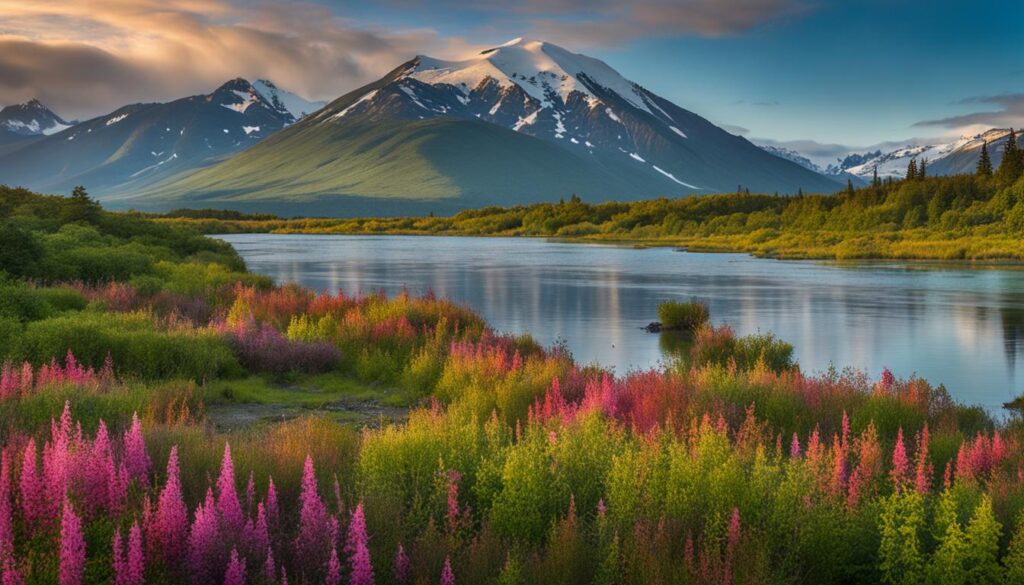
When it comes to scenic spots, Katmai National Park does not disappoint. From breathtaking waterfalls to panoramic vistas, there are plenty of photo opportunities to capture the beauty of this pristine wilderness.
Brooks Falls Observation Platform
One of the most iconic and picturesque viewpoints in Katmai is the Brooks Falls Observation Platform. Here, you can witness the awe-inspiring sight of brown bears catching salmon as they leap up the cascading waterfalls. It’s a truly remarkable experience and a must-visit spot for wildlife enthusiasts and photographers alike. The platform offers a safe and elevated vantage point for observing these magnificent creatures in their natural habitat.
Dumpling Mountain
Situated in the heart of Katmai National Park, Dumpling Mountain provides hikers with stunning panoramic views of the surrounding landscapes. From its summit, you can enjoy a bird’s eye perspective of the park’s diverse terrain, including lush forests, snow-capped peaks, and shimmering lakes. It’s the perfect spot to pause, take in the beauty of nature, and snap some memorable photos.
Valley of Ten Thousand Smokes Overlook
For a unique and mesmerizing sight, head to the Valley of Ten Thousand Smokes Overlook. From this vantage point, you can marvel at the otherworldly landscape created by the 1912 volcanic eruption. The valley is filled with ash deposits, steam vents, and rugged terrain, creating a scene that is both dramatic and fascinating. It’s a truly remarkable sight that will leave you in awe of the raw power of nature.
Trip Planning for Hiking in Katmai
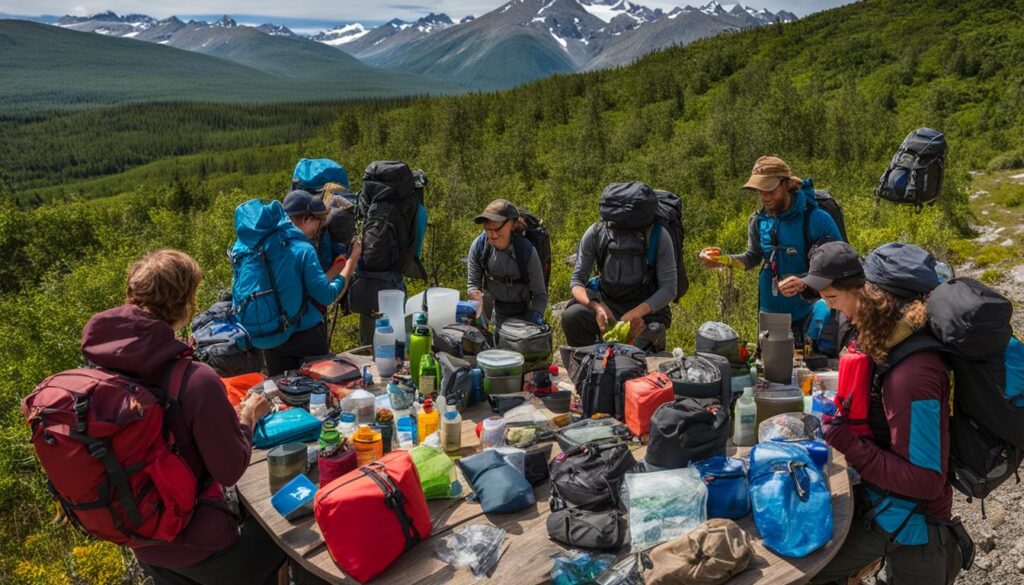
When preparing for a hiking adventure in Katmai National Park, there are several important factors to consider. From obtaining the necessary permits to making transportation arrangements and securing camping reservations, proper trip planning is essential to ensure a smooth and enjoyable experience.
First and foremost, it’s crucial to obtain the required hiking permits for Katmai. These permits may include backcountry hiking permits, which allow you to explore remote areas of the park. By obtaining the necessary permits, you can ensure that you are hiking within the designated areas and following the park’s regulations.
Transportation to Katmai should also be taken into account. Depending on your location, you may need to arrange air or boat transportation to reach the park. It’s important to research and book your transportation in advance to avoid any last-minute complications.
Additionally, if you plan on camping during your hiking trip, it’s advisable to make camping reservations. This is especially important during peak seasons when campsites can fill up quickly. By securing camping reservations, you can guarantee a spot at your desired campground and make your trip more convenient and comfortable.
Safety Tips for Hiking in Katmai
When embarking on a hiking adventure in Katmai National Park, prioritizing safety is crucial. Here are some essential tips to ensure a safe and enjoyable experience:
1. Hiking Safety:
Always be prepared for changing weather conditions and pack appropriate layers of clothing. Carry a first aid kit, navigation tools, and communication devices in case of emergencies. It’s also important to inform someone about your hiking plans and estimated return time.
2. Bear Safety:
Katmai is home to a significant population of brown bears, and encounters are possible while hiking. Carry bear spray and know how to use it effectively. Make noise while hiking to avoid surprising bears and maintain a safe distance of at least 100 yards. Store food and scented items properly to avoid attracting wildlife.
3. Wilderness Safety:
When exploring the wilderness of Katmai, it’s essential to respect the environment and adhere to the park’s regulations. Practice Leave No Trace principles by disposing of waste properly and leaving natural objects undisturbed. Stay on designated trails and avoid approaching wildlife to ensure their safety and yours.
By following these safety tips, you can fully enjoy the wonders of hiking in Katmai while minimizing risks and preserving the park’s pristine wilderness.
| Tip | Description |
|---|---|
| Hiking Safety | Be prepared for changing weather, carry necessary equipment, and inform someone about your plans. |
| Bear Safety | Carry bear spray, make noise while hiking, and store food properly to avoid attracting bears. |
| Wilderness Safety | Respect the environment, follow park regulations, and practice Leave No Trace principles. |
Nearby Camping Options
When planning your hiking adventure in Katmai National Park, consider the various camping options available to you. Whether you prefer to stay in designated campgrounds or venture into the backcountry, there are options to suit every camper’s preference.
If you’re looking for a camping experience with basic amenities and proximity to the main hiking trails, the Brooks Camp Campground is a popular choice. Located near the iconic Brooks Falls, this campground offers beautiful surroundings and the opportunity to witness bears catching salmon in the nearby river. It’s important to note that reservations for the Brooks Camp Campground must be made in advance.
| Campground | Amenities | Location |
|---|---|---|
| Brooks Camp Campground | Restrooms, food storage, picnic tables | Near Brooks Falls |
| Backcountry Camping | Primitive camping, no amenities | Various locations throughout the park |
If you’re seeking a more secluded and immersive experience, backcountry camping in Katmai is an excellent option. This allows you to explore remote areas of the park and truly connect with nature. However, it’s essential to be well-prepared and knowledgeable about backcountry regulations and safety protocols. Remember to practice Leave No Trace principles and ensure you have all the necessary camping gear and supplies for a successful trip.
Whichever camping option you choose, always prioritize safety, respect the park’s rules and regulations, and be mindful of the natural environment. Camping near Katmai National Park offers a unique opportunity to fully immerse yourself in the wilderness and create lasting memories in this incredible natural setting.
Conclusion
Hiking in Katmai National Park has been an incredible journey, filled with awe-inspiring landscapes, thrilling wildlife encounters, and a deeper appreciation for the park’s rich history. Whether you tackled the challenging trails or opted for a leisurely walk, Katmai never fails to leave a lasting impression.
As I reflect on my adventures in Katmai, I am reminded of the breathtaking views from scenic viewpoints such as Brooks Falls and Dumpling Mountain. The opportunity to witness bears catching salmon and to capture the beauty of Katmai through my camera lens is truly unforgettable.
My final thoughts on Katmai hiking are filled with gratitude for the opportunity to explore this pristine wilderness. I am reminded of the importance of careful trip planning, from obtaining permits to packing the right gear. Safety in the wilderness should always be a priority, particularly when it comes to bear encounters and ever-changing weather conditions.
Let us cherish and protect this remarkable place for future generations of hikers. Katmai National Park is a true gem, offering a unique blend of natural wonders and unforgettable experiences. Happy hiking in Katmai!
FAQ
What are some easy hiking trails in Katmai National Park?
Some easy hiking trails in Katmai National Park include the Brooks River Trail, Dumpling Mountain Trail, and the Valley of Ten Thousand Smokes Overlook Trail.
What are some challenging hiking trails in Katmai National Park?
Some challenging hiking trails in Katmai National Park include the Katmai Valley Route, Alagnak Wild River Trail, and Novarupta Trail.
What are the differences between summer and winter hiking in Katmai National Park?
In the summer, the park is alive with wildlife and lush vegetation, while winter offers a different kind of beauty with snow-covered landscapes. Summer hiking is more accessible, while winter hikes require extra precautions and preparation.
What is the historical significance of Katmai National Park?
Katmai National Park is home to archaeological sites that offer insights into ancient cultures and preserves the legacy of the 1912 volcanic eruption that shaped the landscape and created the Valley of Ten Thousand Smokes.
What geological wonders can be seen in Katmai National Park?
Katmai National Park offers diverse geological formations and volcanic landscapes, with highlights including the Valley of Ten Thousand Smokes, volcanic ash deposits, steam vents, and rugged terrain.
What wildlife can be encountered on hikes in Katmai National Park?
Katmai National Park is home to a rich diversity of wildlife, including brown bears, moose, wolves, and a variety of bird species. Coastal areas may also offer sightings of marine life such as seals and whales.
Where can I find scenic viewpoints in Katmai National Park?
Scenic viewpoints in Katmai National Park include the observation platforms at Brooks Falls, Dumpling Mountain, and the Valley of Ten Thousand Smokes Overlook.
How should I plan my trip for hiking in Katmai National Park?
Plan your trip by obtaining any necessary permits, familiarizing yourself with park regulations, arranging transportation, and considering camping reservations. Be sure to pack the right gear, including sturdy hiking boots, layers of clothing, and essential camping equipment.
What safety measures should I take while hiking in Katmai National Park?
Be bear aware and follow the park’s guidelines for bear encounters. Carry bear spray, make noise while hiking, and store food properly. Be prepared for changing weather conditions and carry essential safety items such as a first aid kit, navigation tools, and communication devices.
Are there camping options near Katmai National Park?
Yes, camping options near Katmai National Park include designated campgrounds and backcountry camping. Brooks Camp Campground is a popular choice for amenities and proximity to hiking trails.

